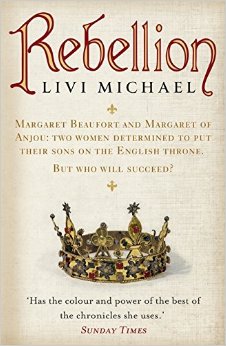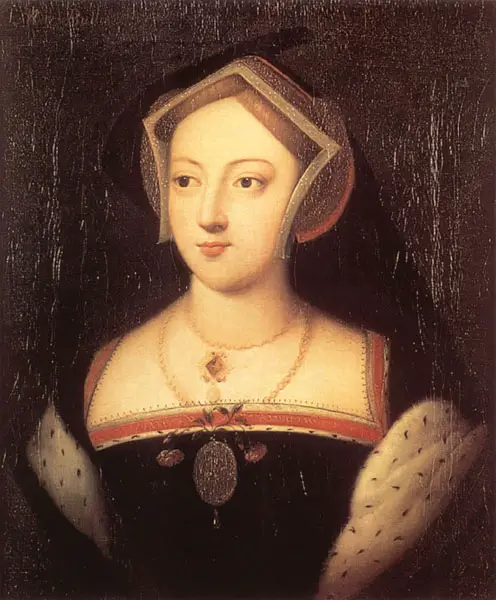 On 19th July 1553, thirteen days after the death of her half-brother Edward VI, Mary, eldest daughter of Henry VIII, was proclaimed queen in London in place of Queen Jane, who had been proclaimed queen on 10th July.
On 19th July 1553, thirteen days after the death of her half-brother Edward VI, Mary, eldest daughter of Henry VIII, was proclaimed queen in London in place of Queen Jane, who had been proclaimed queen on 10th July.
The Chronicle of the Grey Friars of London records:
"Item the xix. day of the same monyth, [which] was sent Margarettes evyne, at iiij. of clocke at after-none was proclamyd lady Ma[ry to] be qwene of Ynglond at the crose in Cheppe with the erle of Shrewsbery, the earle [of Arundel], the erle of Pembroke, with the mayer of London, and dyvers other lordes, and many of the ald[dermen] and the kynges schrffe master Garrand, with dyvers haroldes and trompettes. And from thens cam to Powlles alle, and there the qwere sange Te Deum with the organs goynge, with the belles ryngynge, the most parte alle [London], and that same nyght had the [most] parte of London Te Deum, with bone-fyers in every strete in London, with good chere at every bone [fyer], the belles ryngynge in every parych cherch, and for the most parte alle nyght tyll the nexte daye to none."
Here is a brief timeline of the events leading up to Mary being proclaimed queen:
- 21 June 1553 - Letters patent were issued changing Edward VI's heir from his half-sister Mary to Lady Jane Grey, the eldest daughter of Edward’s cousin Frances Brandon, Duchess of Suffolk.
- 6 July 1553 - Death of Edward VI at Greenwich Palace.
- 7 July 1553 - Goldsmith Robert Reyns informed Mary (future Mary I) of Edward VI's death. Mary was staying with Lady Burgh at Euston Hall, near Thetford, and Reyns had rushed from London to give her the news.
- 8 July 1553 - Mary Tudor, daughter of Henry VIII, declared herself Queen at Kenninghall following news of King Edward VI's death.
- 9 July 1553 - Nicholas Ridley, Bishop of London, preached at St Paul’s Cross denouncing Henry VIII's daughters, Mary and Elizabeth, as bastards. The congregation were “sore annoyed with his words”. The Duke of Northumberland officially informed Lady Jane Grey of Edward VI’s death in front of the Council and nobles, going on to explain the terms of Edward’s will which named Lady Jane Grey as the heir to the throne. Lady Jane Grey accepted that she was Queen. Mary wrote to the Privy Council stating her claim to the throne and demanding their allegiance.
- 10 July 1553 - Lady Jane Grey, her husband, Guildford Dudley, her parents and Guildford’s mother arrived by barge at the Tower of London, having travelled from Syon. At the Tower, two heralds then proclaimed that Lady Jane Grey was now Queen of England before they moved on to proclaim their message in Cheapside and Fleet Street. At Cheapside, a boy declared that it was Mary who was the rightful queen, and he was punished the next morning by having his ears cut off.
Also, on this day, Mary's letter to the council arrived. - 12 July 1553 - Mary moved from Kenninghall to Framlingham Castle, where she began to rally support. Back in London, according to The Chronicle of Queen Jane and of Two Years of Queen Mary, and Especially of the Rebellion of Sir Thomas Wyat, Queen Jane's council decided that "the duke of Suffolk with certaine other noblemen, should goe towards the lady Mary, to fetch her up to London".
- 12-15 July 1553 - Mary's supporters and forces grew. She was supported by men such as Sir Edward Hastings; Henry Radclyffe, Earl of Sussex; Sir Thomas Cornwallis; Thomas, Lord Wentworth; Sir Henry Bedingfield; John de Vere, Earl of Oxford; and many prominent families of eastern England such as the Rochesters, the Jerninghams and Waldegraves. Mary was proclaimed Queen in various counties and towns.
- 15 July 1553 - The royal ships guarding the Eastern coast for 'Queen Jane' swapped their allegiance to 'Queen Mary'. Their crews had not been paid, and they received a visit from Sir Henry Jerningham asking them to support Mary instead, so it was an easy decision.
- 16 July 1553 - Mary received reports that forces supporting her claim to the throne were preparing to move from Oxfordshire "to mershe forth towards the Palace of Westminster, wher there purpose ys to apprehende Mr. Jobson...", Mr Jobson being Sir Francis Jobson, who was married to the Duke of Northumberland's half-sister, and who was holding the palace in Queen Jane's name.
The Chronicle of Queen Jane also reports that at around 7pm on 16th July "the gates of the Tower upon a sudden were shut, and the keyes caryed upp to the queen Jane". - 18 July 1553 - While John Dudley, Duke of Northumberland, and his forces made their way from Cambridge to Bury St Edmunds to stand against Mary's men, the Earls of Pembroke and Arundel called a council meeting and betrayed Northumberland and Queen Jane. They persuaded many council members that Mary's claim to the throne was legitimate. In The Lives of the Lord Chancellors and Keepers of the Great Seal of England (1848), John, Lord Campbell, writes of the Earl of Pembroke's persuasion techniques:
"The Earl of Pembroke then drew his sword, exclaiming, "If the arguments of my Lord of Arundel do not persuade you, this sword shall make Mary queen, or I will die in her quarrel."" - 19 July 1553 - Mary was proclaimed queen.
While Mary was being proclaimed queen, the Duke of Suffolk, Lady Jane Grey's father, was interrupting his daughter's evening meal to inform her that she was no longer queen. Her canopy of state was then taken down and Lady Jane Grey turned from Queen to prisoner.
Mary didn't actually know that she had been proclaimed Queen at this point. She found out the next day when William Paget and the Earl of Arundel arrived at Framlingham with the news.
Notes and Sources
- The Chronicle of the Grey Friars of London, Camden Society Old Series, Volume 53. Originally published by Camden Society, London, 1852 - you can read this at http://www.british-history.ac.uk/camden-record-soc/vol53/pp80-98#fnn1
- The Lives of the Lord Chancellors and Keepers of the Great Seal of England (1848), John, Lord Campbell, p. 37. - this can be read on Google Books
- Mary Tudor: Renaissance Queen blog.



I have often wondered why Mary was proclaimed Queen, when Edward VI had every right to decide who would succeed him. His will would or should have superseded his father’s. I agree with Kyra Kamer’s article that Mary I was the usurper and not Jane
I think, since Jane was an unknown compared to Mary, the people wanted Mary as Queen as well as the many members of the Catholic nobility.
Thanks again for great read!
Ricki
I think it was because Edward was still in his minority when he died. He could be painted as being manipulated by John Dudley and the Greys, and Mary could go back to her father’s will.
When the adults thought a kid was getting a little “uppity”, they would call us Lady Jane. As in “What do you think you’re doing, Lady Jane.”
Yes, my mother would call me “Lady Jane” when I was deemed impertinent or up to miscihief. No need to add the last name as ours was Gray.
About time too, poor Mary was denied her right for too long. Long live Queen Mary and down with the Greys. Up the Tudors.
It may have been her birthright, but Henry VIII had never repealed the Acts of Succession which made her illegitimate, and law from the 13th century, which was still legal and valid, made it so that illegitimate children could not inherit. Edward VI’s devise was, therefore, legal and right in that he chose a legitimate heir of Tudor blood. It’s an interesting topic.
Good grief this was a period of much tumour and bloodshed. I find your comment quite disturbing
Turmoil !